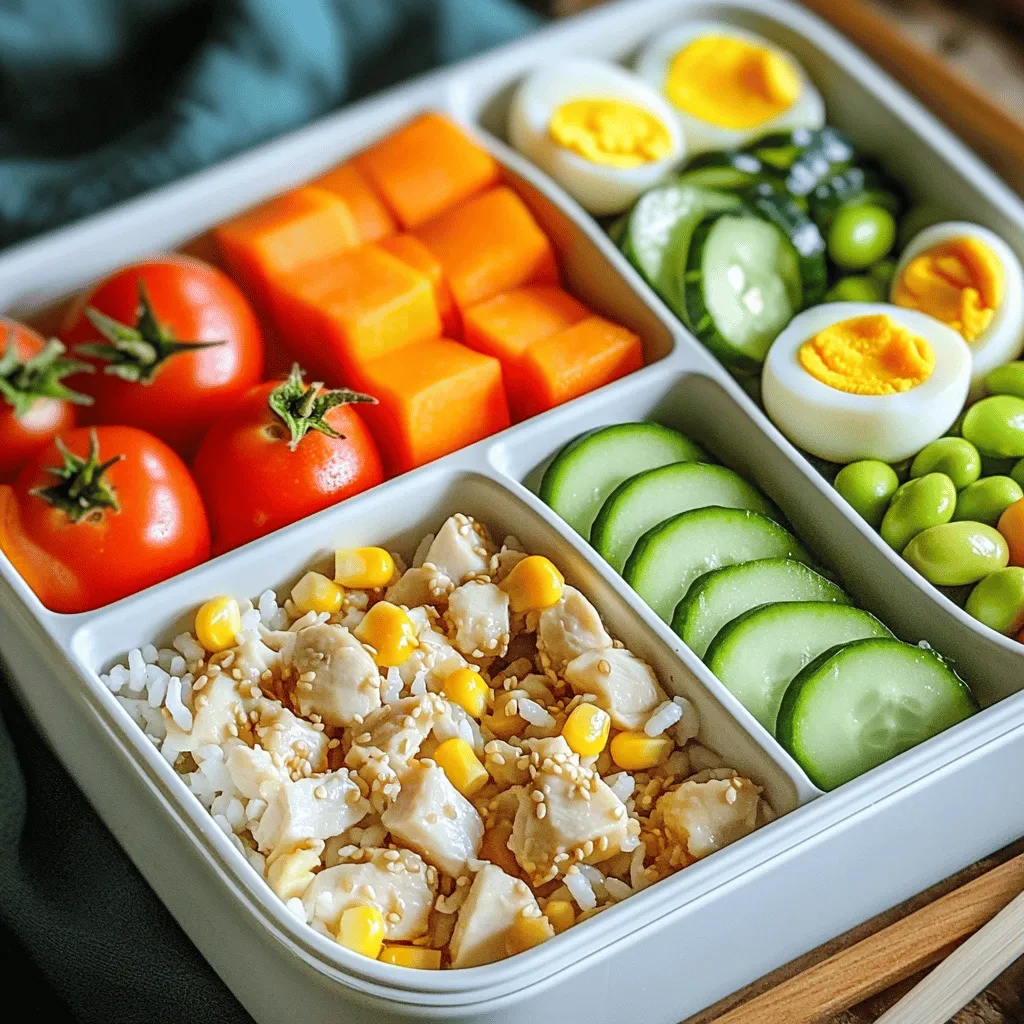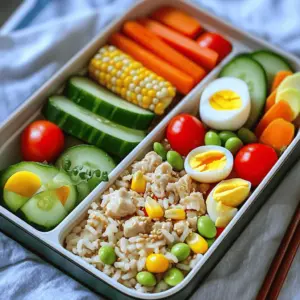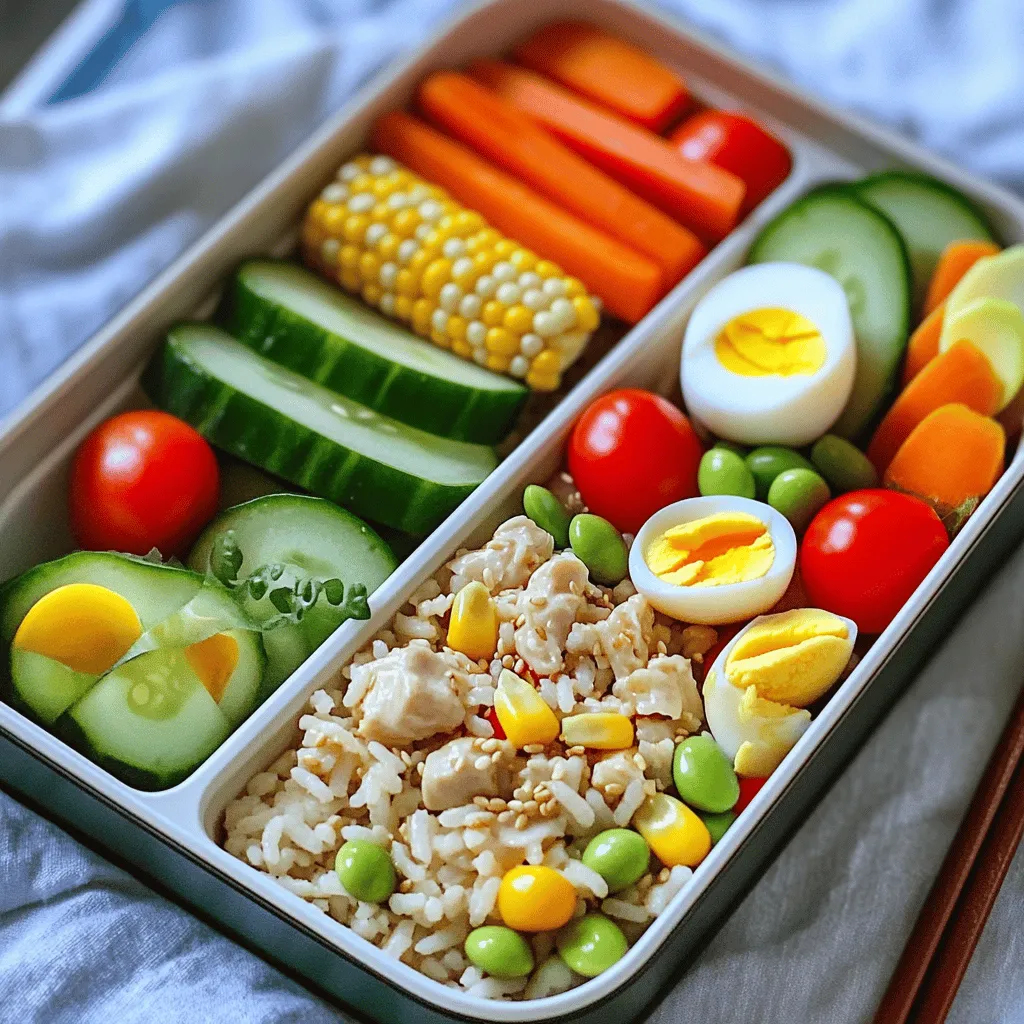Are you tired of the same old lunch options for your kids? Let’s change that with fun and tasty bento lunches! In this guide, you’ll discover easy ingredients, fun presentation ideas, and step-by-step instructions to create colorful bento boxes that kids will love. Say goodbye to lunchtime boredom and hello to exciting meals packed with flavor and nutrition. Ready to make lunchtime fun? Let’s dive in!
Ingredients
Essential Ingredients for Bento Lunches
When you make bento lunches, having the right ingredients is key. Each bite needs to be fun and tasty.
– Rice and Protein Choices
– Start with 1 cup cooked jasmine rice. This rice is soft and sticky, perfect for packing.
– Add a protein like 1/2 cup cooked chicken, diced. You can use grilled, baked, or even rotisserie chicken.
– For a veggie option, try tofu or beans. They add protein and flavor.
– Colorful Vegetables and Fruits
– Use 1/2 cup cucumber, thinly sliced. Cucumbers add a nice crunch.
– Include 1/2 cup cherry tomatoes, halved. These bring a burst of sweetness.
– Add 1/4 cup baby carrots, cut into sticks. They are great for munching.
– For a pop of color, toss in 1/4 cup sweet corn. This could be canned or fresh.
– Optional Garnishes and Seasonings
– Drizzle in 2 tablespoons soy sauce (low sodium) for flavor.
– Add 1 tablespoon sesame oil for a rich taste.
– Sprinkle 1 tablespoon sesame seeds for a nice touch.
– Don’t forget 2 hard-boiled eggs, peeled and halved. They are filling and fun.
– For a finishing touch, use seaweed sheets for decoration. You can cut these into fun shapes to make your bento lively.
These ingredients combine to make a well-rounded bento lunch. You can mix and match to keep things exciting. Try the full recipe to see how everything comes together!
Step-by-Step Instructions
Preparing the Rice
1. Cooking Instructions for Jasmine Rice: Start with one cup of jasmine rice. Rinse it well under cold water. Then, cook according to the package instructions. Usually, this involves a 1:1.5 rice-to-water ratio. Bring water to a boil and add the rice. Reduce heat, cover, and simmer until tender.
2. Mixing in Flavor Enhancers: Once the rice is cooked, fluff it with a fork. Add one tablespoon of sesame oil and one tablespoon of sesame seeds. This gives the rice a nice nutty flavor.
3. Cooling Tips for Rice: Spread the rice on a plate to cool it quickly. This prevents it from becoming sticky. Let it cool completely before packing it into the bento box.
Marinating the Chicken
1. Recommended Marinade Ingredients: For the chicken, use half a cup of diced cooked chicken. Mix it with two tablespoons of low-sodium soy sauce. This will add a savory taste that kids love.
2. Time Recommendations for Marination: Let the chicken marinate for about ten minutes. This short time allows the flavors to soak in without making it too salty.
Preparing Other Components
1. Hard-Boiling Eggs Properly: To make two hard-boiled eggs, place them in a pot of cold water. Bring the water to a boil. Once boiling, cook for ten minutes. Then, move them to cold water for easy peeling.
2. Cutting and Preparing Vegetables: Prepare the veggies while the chicken marinates. Slice half a cucumber thinly. Halve the cherry tomatoes and cut baby carrots into sticks. If using fresh corn, cook it until tender and cool it down.
3. Assembling the Bento Box Efficiently: Start by adding the cooled rice to one compartment of the bento box. Next, place the marinated chicken beside it. In another section, arrange the cucumber, tomatoes, corn, and carrot sticks. Add the halved hard-boiled eggs and a portion of shelled edamame.
Now you have a colorful and fun bento lunch ready to go! For the full recipe, check out Bento Bliss: Colorful Kids’ Lunchbox.
Tips & Tricks
Packing a Nutritionally Balanced Bento
Serving Sizes for Kids
When packing bento lunches, keep portions small. Kids do best with smaller servings. Aim for about:
– 1/2 cup of rice
– 1/4 cup of protein
– 1/2 cup of veggies
These sizes help avoid waste and keep kids energized.
Incorporating Food Groups
A balanced bento includes all food groups. Include:
– Grains (like rice or quinoa)
– Proteins (like chicken or tofu)
– Vegetables (like cucumbers or carrots)
– Fruits (like berries or apple slices)
Mixing these makes lunches healthy and tasty.
Creative Presentation Ideas
Using Fun Shapes and Colors
Kids love fun! Use cookie cutters to create shapes. Try making:
– Star-shaped sandwiches
– Heart-shaped fruit
Colorful foods attract kids’ eyes too. Use bright veggies and fruits to make meals pop.
Using Seaweed for Decoration
Seaweed can add flair. Use it to:
– Create funny faces on rice or eggs
– Wrap around sushi rolls
Kids enjoy the playful designs. Plus, seaweed adds flavor and nutrients.
Meal Prep Tips
Prepping in Advance for Busy Days
Make bento lunches easier by prepping ahead. Cook rice and proteins on the weekend. Store them in the fridge. Cut veggies and fruits the night before. This saves time on busy mornings.
Storing Bento Components Separately
Keep ingredients fresh by storing them apart. Use small containers for each food group. This way, flavors don’t mix, and everything stays crisp. It also makes assembly quick and easy.
For more ideas, check out the Full Recipe for Bento Bliss: Colorful Kids’ Lunchbox.

Variations
Different Protein Options
When you make bento lunches, the protein choice can change the whole meal.
– Vegetarian Choices: You can use tofu, chickpeas, or tempeh. These options add great taste and texture. Try marinating tofu in soy sauce for flavor. It’s also fun to shape it into cute forms.
– Seafood Options: Fish like salmon or shrimp can add a twist to your bento. Cooked shrimp is easy to eat and packed with protein. You can also use canned tuna mixed with a little mayo for a tasty spread.
Alternative Base Ingredients
Switching up your base can make each bento unique.
– Quinoa or Brown Rice Variants: Quinoa is a great swap for rice. It cooks quickly and is full of nutrients. Brown rice is also a hearty option, giving a nutty flavor. Both grains work well with many toppings.
– Noodle-based Bento Options: Try using soba or rice noodles as your base. They are fun and different. Add some veggies and protein on top for a colorful meal.
Seasonal Ingredients to Incorporate
Using seasonal ingredients keeps your bento fresh and exciting.
– Summer Fruits and Vegetables: In summer, add fruits like strawberries or watermelon. They are sweet and refreshing. Vegetables like bell peppers and cucumbers are crunchy and fun to eat.
– Winter Comfort Additions: In colder months, root vegetables like carrots or sweet potatoes are great. They add warmth and comfort. You can roast them for extra flavor.
For a complete bento experience, check out the Full Recipe. It has a wonderful mix of flavors and colors!
Storage Info
Best Practices for Storing Bento Lunches
Temperature Control and Safety
Keeping your bento lunch safe is key. Aim to keep your food below 40°F (4°C). Use ice packs if you pack your bento for school. This helps keep proteins and other perishables fresh. If your child eats lunch after a long break, this is especially important.
Containers to Use for Max Freshness
Choose airtight containers for your bento. These containers help keep moisture in and air out. Look for bento boxes with separate compartments. This keeps each food item separate and fresh. Silicone liners can also help keep foods from mixing.
How to Keep Ingredients Fresh
Tips on Keeping Vegetables Crisp
To keep veggies fresh, wash and dry them before packing. Store cucumbers and carrots in a damp paper towel. This helps keep them crisp during the day. You can also pack them in a small container with a lid. This way, they stay crunchy and tasty.
Preventing Rice from Drying Out
To stop rice from drying out, keep it covered. Once it’s cool, place it in your bento box right away. Add a small piece of damp paper towel on top. This will help lock in moisture. If you use jasmine rice, it stays moist longer. This makes it a great choice for your bento.
Remember to check the full recipe for more tips!
FAQs
What are bento lunches?
Bento lunches are Japanese-style meals packed in a box. They often feature rice, protein, and colorful veggies. The main goal is to create a balanced meal. Each section of the bento box holds different foods, making lunch fun and varied. You can customize bento boxes to fit your child’s tastes and preferences. They are great for school or picnics.
How can I make bento lunches appealing for picky eaters?
To attract picky eaters, focus on color and shape. Use bright vegetables like carrots, bell peppers, and cherry tomatoes. Cut food into fun shapes using cookie cutters. This makes meals look exciting. You can also include dips, like ranch or hummus, to encourage kids to try new foods. Add familiar favorites alongside new items. Experiment with different combinations to find what works best.
Can I prepare bentos the night before?
Yes, you can prepare bentos the night before. This saves time on busy mornings. Store each food in separate airtight containers to keep them fresh. Assemble the bento box in the morning for a quick grab-and-go option. Make sure to include cold packs if needed to keep food safe.
Are bento boxes dishwasher safe?
Most bento boxes are not dishwasher safe. Check the care instructions for your specific box. Hand washing with mild soap is usually best. This helps maintain the box’s shape and design. Avoid using harsh scrubbers that can scratch the surface. Proper care will keep your bento box looking new and lasting longer.
In summary, making bento lunches involves key ingredients like rice and protein, plus colorful veggies. We discussed step-by-step tips for cooking rice, marinating chicken, and assembling your bento. Creative ideas will help make the lunches fun. Always remember to store your bentos properly to maintain freshness.
Bento lunches can be healthy and exciting for everyone. With a little planning, you can enjoy a delicious and fun meal every day!

